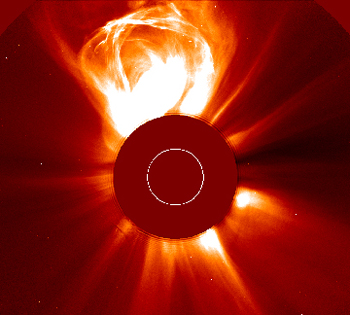 For the first time,
scientists have observed a solar superstorm with an array of spacecraft scattered
throughout the solar system. The gigantic flares and coronal mass ejections
of late October and early November 2003 ejected billions of tons of hot plasma
from the sun, at speeds up to 5 million miles per hour, bathing the solar system
in large doses of radiation. Although the superstorms had some negative impacts
on Earth, they gave solar researchers unprecedented new data on these rare events
— including some data that may help to explain the disappearance of water
from Mars.
For the first time,
scientists have observed a solar superstorm with an array of spacecraft scattered
throughout the solar system. The gigantic flares and coronal mass ejections
of late October and early November 2003 ejected billions of tons of hot plasma
from the sun, at speeds up to 5 million miles per hour, bathing the solar system
in large doses of radiation. Although the superstorms had some negative impacts
on Earth, they gave solar researchers unprecedented new data on these rare events
— including some data that may help to explain the disappearance of water
from Mars.This image, taken by the SOHO spacecraft as part of a 3-D imaging project, shows a large mass ejection from the sun on Feb. 26, 2000. The shaded disk is a mask in the instrument that blots out direct sunlight; the white circle shows the size and position of the visible sun. Researchers are further studying solar storms, including the 2003 Halloween storms, through an array of spacecraft to better understand their effects throughout the solar system, including on Mars. Image courtesy of SOHO/LACSO; ESA/NASA.
On Earth, the Halloween storms caused magnetic storms, intense red auroras as far south as Florida and the eruption of dense plumes of charged particles over the equator. The Halloween storms disrupted GPS and communications satellites, short-wave radio signals and power grids, and caused the redirection of airplanes to more southerly routes.
The effects of such storms on Mars are quite different. “Mars possesses no significant intrinsic magnetic field,” write Naoki Terada and Hiroyuki Shinagawa of the Solar-Terrestrial Environment Laboratory at Nagoya University, Japan, in an explanation of their recent model results. “The absence of a magnetic protection allows the supersonic solar wind flow to directly interact with the martian ionosphere.” And the behavior of Mars’ ionosphere, a charged region of the upper atmosphere from which ions can escape under certain conditions, may help explain the apparent lack of water on Mars.
Scientists think there was once enough water on Mars to cover the planet to a depth of a few hundreds of meters, and what happened to that water is a pressing question in many fields of astrobiology and other related fields. In the early 1980s, based on data from the Viking landers that had descended through Mars’ ionosphere, scientists proposed that the solar wind may have slowly stripped away Mars’ water, ion by ion, over 3.5 billion years.
To further develop this idea, Terada and Shinagawa modeled how oxygen could be lost to the solar wind by increasing the solar wind dynamic pressure to replicate conditions during the superstorms. During high-pressure periods, such during the Halloween storms, they found that the ionosphere becomes compressed, which pushes the ionopause, a boundary layer between the ionosphere and the solar wind, down to a lower altitude. This shift exposes more of the atmosphere, and therefore more oxygen ions, to the solar wind, which whisks them into space.
The solar wind essentially scavenges oxygen ions — in a process scientists believed happened at a much higher rate in the past. Indeed, the present-day loss of oxygen ions, while significant, is small compared to the loss rates 3.5 billion years ago, says Andrew Nagy, a researcher at the University of Michigan who studies the martian ionosphere.
Terada and Shinagawa write that the total amount of water escaped from Mars over the past 3.5 billion years via scavenging processes induced by solar wind is equivalent to a global martian ocean layer about 10 meters deep. That estimate is “an order of magnitude smaller,” they write, than the 156-meter-deep ocean layer that the Mars Global Surveyor observations estimate the planet would have had at the time. Thus, the results of the new model explain where some, but not all, of Mars’ water may have gone have gone.
No liquid water has been found on Mars’ surface today; however, “an estimated 20 to 30 meters of equivalent ocean depth is likely stored in the present Mars polar ice cap, and maybe more in subsurface reservoirs,” Nagy says. Researchers suspect the rest was lost due to other types of solar interaction operating in the distant past, when the radiation from the sun was significantly greater, he adds.
Scientists will continue to learn more about the impacts of solar events throughout the solar system, says Thomas Zurbuchen of the Space Physics Research Laboratory at the University of Michigan. “We have never really had observations at different vantage points throughout interplanetary space of an impulsive disturbance as extreme as the Halloween superstorms,” he says. “It’s like finally having a small network of weather stations sparsely distributed over the Earth and watching a hurricane blow through.”

